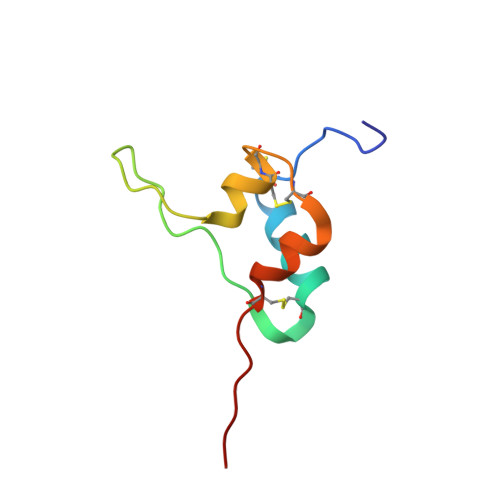Probing Receptor Specificity by Sampling the Conformational Space of the Insulin-like Growth Factor II C-domain.
Hexnerova, R., Krizkova, K., Fabry, M., Sieglova, I., Kedrova, K., Collinsova, M., Ullrichova, P., Srb, P., Williams, C., Crump, M.P., Tosner, Z., Jiracek, J., Veverka, V., Zakova, L.(2016) J Biological Chem 291: 21234-21245
- PubMed: 27510031
- DOI: https://doi.org/10.1074/jbc.M116.741041
- Primary Citation of Related Structures:
5L3L, 5L3M, 5L3N - PubMed Abstract:
Insulin and insulin-like growth factors I and II are closely related protein hormones. Their distinct evolution has resulted in different yet overlapping biological functions with insulin becoming a key regulator of metabolism, whereas insulin-like growth factors (IGF)-I/II are major growth factors. Insulin and IGFs cross-bind with different affinities to closely related insulin receptor isoforms A and B (IR-A and IR-B) and insulin-like growth factor type I receptor (IGF-1R). Identification of structural determinants in IGFs and insulin that trigger their specific signaling pathways is of increasing importance in designing receptor-specific analogs with potential therapeutic applications. Here, we developed a straightforward protocol for production of recombinant IGF-II and prepared six IGF-II analogs with IGF-I-like mutations. All modified molecules exhibit significantly reduced affinity toward IR-A, particularly the analogs with a Pro-Gln insertion in the C-domain. Moreover, one of the analogs has enhanced binding affinity for IGF-1R due to a synergistic effect of the Pro-Gln insertion and S29N point mutation. Consequently, this analog has almost a 10-fold higher IGF-1R/IR-A binding specificity in comparison with native IGF-II. The established IGF-II purification protocol allowed for cost-effective isotope labeling required for a detailed NMR structural characterization of IGF-II analogs that revealed a link between the altered binding behavior of selected analogs and conformational rearrangement of their C-domains.
- From the Institute of Organic Chemistry and Biochemistry, Academy of Sciences of the Czech Republic, v.v.i., Flemingovo nám 2, 166 10 Prague 6, Czech Republic, Faculty of Science, Charles University in Prague, Albertov 6, Prague 128 43, Czech Republic.
Organizational Affiliation:
















